Milestones: March 2021

Save The Date
Thursday, April 8th 7:00pm
The Bala Cynwyd Library will host A Brief History of Racial and Ethnic Inequality in Lower Merion, presented by Jerry Francis, President of The Lower Merion Historical Society. Accompanying the talk will be a slide presentation followed by a question & answer session.
Register for this ZOOM session
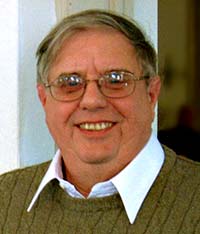 “Social justice can be a difficult topic to talk about and now is the time that we begin this conservation. I decided to start by exploring Lower Merion’s legacy, a Quaker suburb of Philadelphia populated with a patch work of many ethnic people. Only by knowing the past can we understand the present and mold the future, and thus make the most of our own brief histories.”
“Social justice can be a difficult topic to talk about and now is the time that we begin this conservation. I decided to start by exploring Lower Merion’s legacy, a Quaker suburb of Philadelphia populated with a patch work of many ethnic people. Only by knowing the past can we understand the present and mold the future, and thus make the most of our own brief histories.”
“Our story will concern itself with the Lower Merion/Narberth area. The sources for this presentation came from the extensive Archive Collection at The Lower Merion Historical Society.”
Looking For Volunteers
The Historical Society has been providing service to the Lower Merion and Narberth community for more than 73 years. We rely on volunteers to staff our special library and to research our wonderful heritage.
See what our volunteers have accomplished
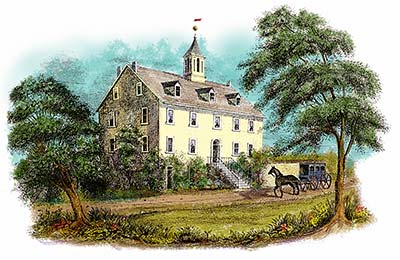 Due to the coronavirus, the Academy building has been closed to the public. But things are looking up and soon we hope to be allowed to re-open to the public. When we do, we will need volunteers to help us staff our library on the second floor of the Lower Merion Academy building. When we re-open our library hours will be Wednesday evenings 7:00pm to 9:00pm and Saturday afternoons 2:00pm to 4:00pm. You can volunteer for whenever you are available. We are looking for individuals who have an appreciation for history and who will be able to greet our patrons. We are a friendly staff and the Academy is a great building to visit or work in.
Due to the coronavirus, the Academy building has been closed to the public. But things are looking up and soon we hope to be allowed to re-open to the public. When we do, we will need volunteers to help us staff our library on the second floor of the Lower Merion Academy building. When we re-open our library hours will be Wednesday evenings 7:00pm to 9:00pm and Saturday afternoons 2:00pm to 4:00pm. You can volunteer for whenever you are available. We are looking for individuals who have an appreciation for history and who will be able to greet our patrons. We are a friendly staff and the Academy is a great building to visit or work in.
Interested? Please email us at info@LowerMerionHistory.org.
Douglas Macfarlan:
Antiquarian, Cartographer, Otolaryngologist
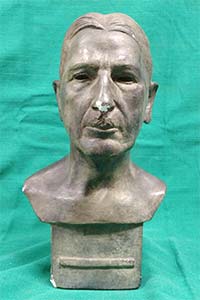 Dr. Douglas Macfarlan was the Society’s second president from 1954 to 1960, yet we could not find a single good photo of our co-founder. So we tracked down one of his granddaughters in Maine, who generously shared some photos of him and his papers.
Dr. Douglas Macfarlan was the Society’s second president from 1954 to 1960, yet we could not find a single good photo of our co-founder. So we tracked down one of his granddaughters in Maine, who generously shared some photos of him and his papers.
She also offered us a plaster bust of her grandfather. “Thank you”, we replied, “but we already have one!” (The unfortunate damage to the nose happens eventually to all great historical figures, from the Great Sphinx onward.)
Dr. Macfarlan was not only a local historian and influential doctor in the treatment of deafness. He was also an accomplished artist and mapmaker, which we showcase on a new web page devoted to Macfarlan’s cartographic art.
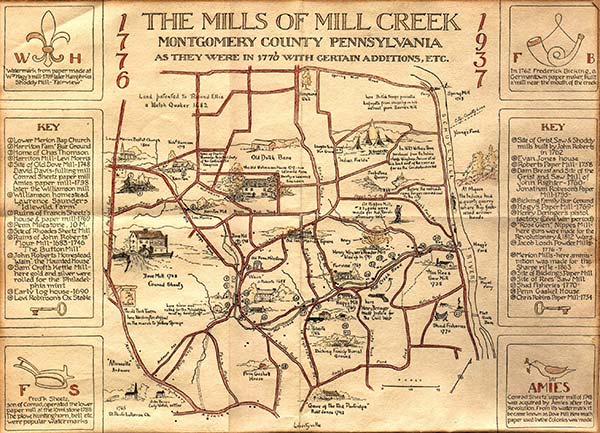
Elm Station Building Sites For Sale!
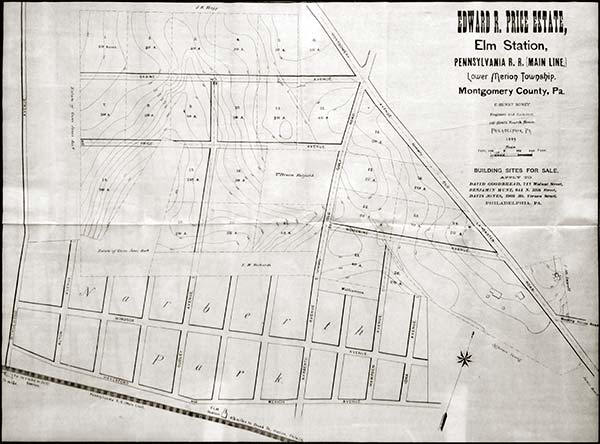
The Society has acquired an 1889 map that had hung in a Narberth family home for generations. It advertises lots for sale on the Edward R. Price estate in 1889, two years after the death of future Narberth’s founder, the last in his family of original Welsh Tract settlers.
It reveals a lot of interesting details about the fledgling village at Elm Station, as the area was then known. Here is one of the first map appearances of the name “Narberth”; the town’s alphabetical streets include the never constructed “A” street, which disappeared from maps forever within 2 years; and topographical contour lines clearly show the grade of Lower Merion’s first railroad, the Philadelphia and Columbia, by then defunct for 50 years.
Examine this fascinating map in detail on our updated Antique Maps page.
Lost And Now Found
And now for some fun stuff…on occasion we do get some truly interesting and unexpected donations to the Society. The story goes…the other day a gentleman visited the Academy and donated these two objects to the Society…see the images below showing the top and the bottom. He found them in July of 1973 partially submerged in Mill Creek at what is today West Mill Creek Park in Gladwyne…just downstream from the 1690 House. They are made of stone and chiseled into a bowl shape and because of the imperfections on the bottom, were they used over an open fire?

So we asked some of our local experts. It is their opinion that they may be “paint pots” for grinding geological materials and clay into colors that the Lenape used to paint their bodies. They could possibly date back to the Archaic Period c. 8000 BCE to c. 1000 BCE.
If you are able to aid us in the identification of these objects, please contact us at info@LowerMerionHistory.org.
Delivered March 16, 2021
